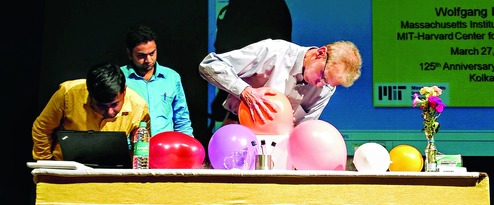
What would happen if you froze a flower to near absolute zero temperature - that is -273° Celsius? It would disintegrate. A banana cooled to that temperature would become rock solid and could be used to hammer a nail into a piece of wood. Nobel laureate Wolfgang Ketterle demonstrated these fascinating features of ultracold matter at a public lecture in Calcutta to commemorate the 125th anniversary of physicist Satyendranath Bose.
Ketterle shares a deep connection with Bose. In 1924, the Indian physicist published a series of papers with Albert Einstein which predicted that a new state of matter - the Bose Einstein Condensate (BEC) - could be generated if atoms were subjected to temperatures close to absolute zero. In this state, atoms would lose their individual properties and start acting collectively as a single entity.
In 1995, the world's first BEC was created by Carl Wieman of the University of Colorado, Boulder, and Eric Cornell of the National Institute of Standards and Technology in Boulder. A few months later, Ketterle and his group at Massachusetts Institute of Technology also produced a BEC with much higher densities. All three were awarded the Nobel Prize for Physics in 2001.
Ever since, Ketterle has been studying the properties of matter at extremely low temperatures. He hopes to discover new forms of matter that could act as superconductors at room temperature. "There is a lot of exciting new research happening at very low temperatures because whenever you lower temperature, you will find something that doesn't happen at higher temperature," said the lanky German physicist, who takes fitness very seriously. He has run the Boston Marathon twice and went off to trek in the Himalayas after completing his work in Calcutta.
At the Science City mini auditorium, he demonstrated a few magical low temperature phenomena. He froze alcohol at -100°Celsius and poured liquid nitrogen (at -200°Celsius) on his hand. To the relief of the audience, his palm was unscathed. "That is because the atmospheric gas forms a layer over my hand and insulates it. But you don't try it at home unless you know exactly what you are doing. I didn't dip my fingers in the liquid nitrogen. If I had, my fingers, like the flower, would turn brittle. Instead, I poured it in my hand so that the atmospheric gas could insulate my fingers," the physicist explained.
Next, he dipped a balloon in liquid nitrogen and then took it out. The balloon shrunk in cold nitrogen but inflated again as soon as it was pulled out and burst. "When we cool gas, the molecules slow down and march in lockstep. They lose their kinetic energy and so the balloon shrinks. But as you take out the balloon from the liquid nitrogen, the gas is again heated to normal temperature and the energy of the particles increases. They expand, causing the balloon to burst," explained Ketterle.
While particles move about randomly at normal temperature, at very low temperatures they march in lockstep - "they are in one big wave where everything oscillates in concert. In BEC, the particles march in lockstep," said Ketterle. "When electrons march in lockstep, they create a current. This current creates a magnetic field which will repel a magnet or exert strong forces on it," he added.
The particles marching in lockstep create a persistent current that does not dissipate. To demonstrate this, Ketterle first showed the audience the phenomena of eddy currents, which eventually decay. "If you move a magnet, the magnetic field changes in a loop of copper or a conductor by Faraday's law of induction. It creates a voltage and current. The current creates a magnetic field that opposes the motion of the magnet," said the physicist.
He dropped a piece of non-magnetised metal through a copper tube, which fell through smoothly. Next, he dropped a magnet through the tube, which fell haltingly. Explaining this, he said: "As it falls, the magnet induces a current in the copper tube which creates an opposing magnetic field that slows down the progress of the magnet. Since the magnetic field slowly decays in the copper tube, the magnet eventually falls through."
Then the physicist made a superconductor. He put a Styrofoam block on the table, placed a copper oxide disc on it and poured liquid nitrogen on it to ultracool it. That made the disc undergo phase transition and the electrons started marching in lockstep. It created a current that does not dissipate.
Ketterle then put a magnet on the superconductor and supercooled that too by pouring liquid nitrogen over it. After a minute, the magnet started floating over the disc. Gasps from the audience and a big round of applause followed.
"The magnetic field created by the electrons marching in lockstep [in the superconductor] repels the magnet, causing it to float," explained the Nobel Laureate, adding "you should be in awe of what you are witnessing".
Everyone in the audience watched the magnet floating over the disc, transfixed.











